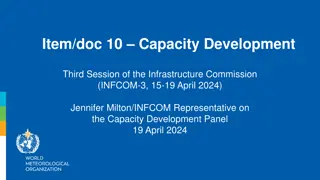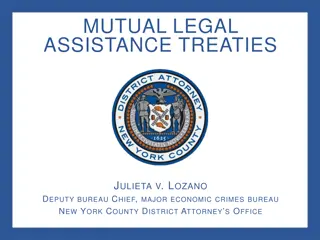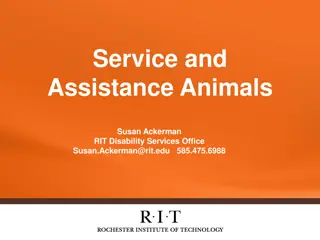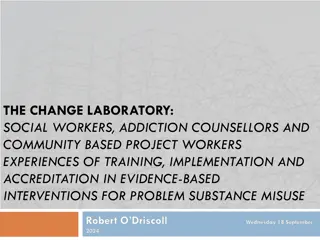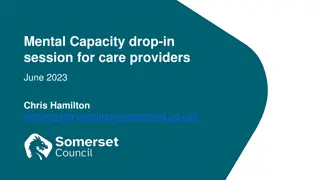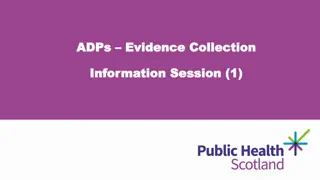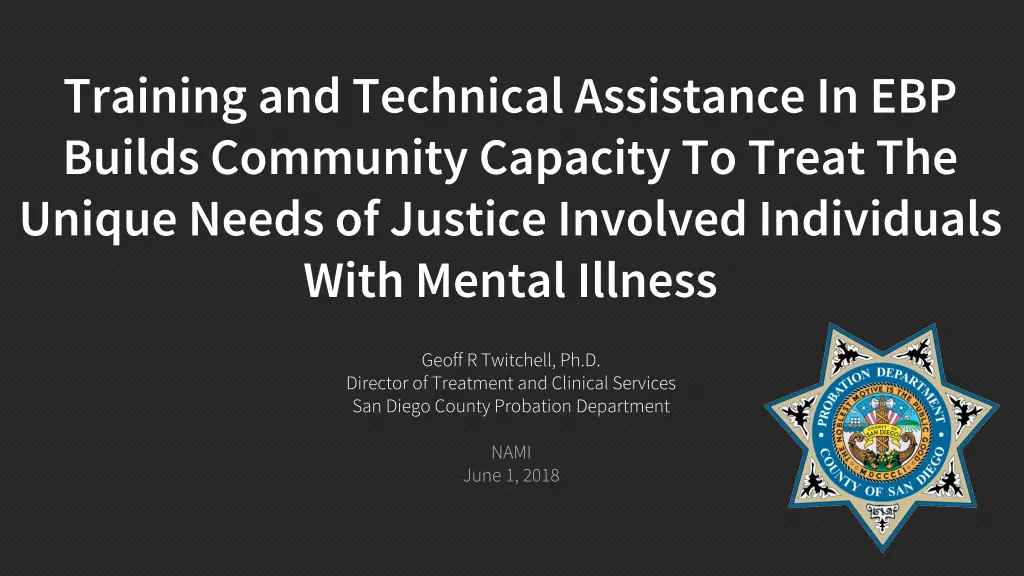
Building Community Capacity Through Evidence-Based Practices for Justice-Involved Individuals with Mental Illness
Explore how training and technical assistance in evidence-based practices (EBP) are essential for treating the unique needs of justice-involved individuals with mental illness. The evolution of EBP in San Diego, the impact of public safety realignment, and the bridging of public safety and public health perspectives are discussed, highlighting the importance of addressing psychiatric risks and reducing recidivism effectively.
Download Presentation

Please find below an Image/Link to download the presentation.
The content on the website is provided AS IS for your information and personal use only. It may not be sold, licensed, or shared on other websites without obtaining consent from the author. If you encounter any issues during the download, it is possible that the publisher has removed the file from their server.
You are allowed to download the files provided on this website for personal or commercial use, subject to the condition that they are used lawfully. All files are the property of their respective owners.
The content on the website is provided AS IS for your information and personal use only. It may not be sold, licensed, or shared on other websites without obtaining consent from the author.
E N D
Presentation Transcript
Training and Technical Assistance In EBP Builds Community Capacity To Treat The Unique Needs of Justice Involved Individuals With Mental Illness Geoff R Twitchell, Ph.D. Director of Treatment and Clinical Services San Diego County Probation Department NAMI June 1, 2018
Focus Supporting Treatment Providers = Better Outcomes TTA via the Correctional Program Checklist (CPC) Developmental educational approach Baseline findings and recommendations Follow-up results 1 year following blueprint TTA via Health and Justice Integration Committee Formalizing CPC process for sustainability BHS-Justice Training Academy Including EBP principles in treatment contracts
Evolution of evidence based practices in SD Began with officers (IBIS) Expanded to treatment providers EBPOST provides training, coaching and mentoring to ensure that Evidence Based Practices become part of the culture The CPC provides education on EBP for the offender population
How did we get here? Public Safety Realignment (AB 109) and Prop 47 Merging philosophies A new population New laws quickly shifted non-violent offenders from institutions to treatment. Current public health providers were asked to take on treatment of a population with unique needs without direction. It has become necessary to simultaneously treat psychiatric risk psychiatric risk and criminogenic targets criminogenic targets.
Traditional concepts VS What Works Mental illness is a direct cause of crime Mental illness is not a driver of criminal behavior Symptoms rarely cause crime VS Psychiatric services rarely reduce crime Symptoms bring contact with police for low level offenses Poverty causes crime Specialty supervision + psychiatric treatment reduces recidivism Jennifer Skeem, Ph.D.
Public Safety/Public Health Bridging two schools of thought via CPC The criminal justice system focuses on risk of violence and recidivism The public health system focuses on psychiatric risk, reducing symptoms, and increasing functioning
Effects of Quality Programs Delivery for Evidenced Based Programs for Youth Offenders 40 30 Reduced Recidivism 20 10 0 Functional Family Therapy 38 -16.7 -10 -20 Increased Recidivism Aggression Replacement Therapy 24 -10.4 Competently Delivered Not Competent Source: Outcome Evaluation of Washington State's Research-Based Programs for Juvenile Offenders. January 2004. Washington State Institute for Public Policy.
CPC Focus Areas Ed Latessa, University of Cincinnati Corrections Institute
SD Health & Justice Integration Committee CPC evaluator training Behavioral Health Services District Attorney Building capacity to provide TTA to our large treatment community Probation Public Defender Sheriff Court
CPC site visit A full day onsite at the program in operation At least four evaluators visit a program Interview clients and review files for treatment targets and goals Interview the Program Director and treatment staff Observe groups
Juvenile Results-T1 Juvenile Day Treatment Mental Health Juvenile Institutional CBT Juvenile Residential Substance Abuse National Average 100% 90% 80% 70% 60% 50% 40% 30% 20% 10% 0% Program Leadership & Development Staff Quality Assurance Offender Assessment Treatment Characteristics Overall Capacity Overall Content Overall Characteristics Capacity Content Overall Very High Adherence to EBP (65%+) High Adherence to EBP (55 - 64%) Moderate Adherence to EBP (46% - 54%) Low Adherence to EBP (45% or less)
Adult Results-T1 Adult Outpatient CBT Adult Outpatient Substance Abuse Adult Residential Substance Abuse Adult Outpatient Mental Health Adult Outpatient Substance Abuse Adult Residential Substance Abuse Adult Outpatient Mental Health Adult Residential Substance Abuse National Average 100% 90% 80% 70% 60% 50% 40% 30% 20% 10% 0% Program Leadership & Development Staff Quality Assurance Offender Assessment Treatment Characteristics Overall Capacity Overall Content Overall Characteristics Capacity Content Overall Very High Adherence to EBP (65%+) High Adherence to EBP (55 - 64%) Moderate Adherence to EBP (46% - 54%) Low Adherence to EBP (45% or less)
Adult Mental Health Results-T1 Adult Outpatient Mental Health Adult Outpatient Mental Health National Average 100% 90% 80% 70% 60% 50% 40% 30% 20% 10% 0% Program Leadership & Development Staff Quality Assurance Offender Assessment Treatment Characteristics Overall Capacity Overall Content Overall Characteristics Capacity Content Overall Very High Adherence to EBP (65%+) High Adherence to EBP (55 - 64%) Moderate Adherence to EBP (46% - 54%) Low Adherence to EBP (45% or less)
Comparison of Providers' Overall CPC Scores from T1 to T2 42.94% increase 55.42% score 66.67% score 79.22% score score Juvenile Day Adult CBT Juvenile IS RTP Very High Adherence to EBP (65%+) High Adherence to EBP (55 - 64%) Moderate Adherence to EBP (46% - 54%) Low Adherence to EBP (45% or less) As of January 15, 2018
Lessons learned Language: Risk = Risk of recidivism Everybody does the CBT (criminogenic focus?) Is that billable? or It s not in my contract! Observation in real time is key
SD Health & Justice Integration Committee Strategies Behavioral health providers must ALSO target criminogenic needs to reduce recidivism EBP BHS- Justice Training Academy Principles Included In Contracts CPC
Summary Training and Technical Assistance in EBP with community treatment providers increases adherence and builds capacity to effectively treat offender populations and decrease recidivism, including offenders with mental health needs. Thank You Contact Info: Geoff Twitchell, Ph.D., geoff.twitchell@sdcounty.ca.gov, 858-514-3175







